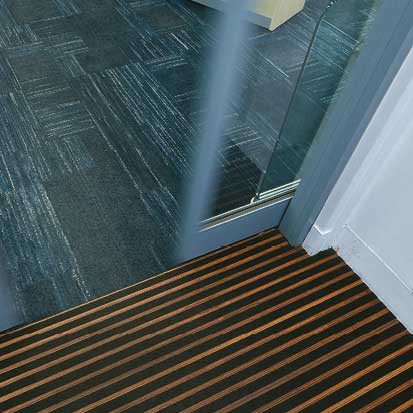Donna Hannaway, Forbo’s Head of Marketing UK and Ireland says the right entrance matting can help maintain a clean, welcoming and safe environment
During the wet winter months, it can become increasingly challenging to keep floors dry and clean, whether that be in a school, hospital, office or public space. Increased rainfall and high foot fall can lead to challenging conditions indoors, with the potential for both dirt and moisture to be trafficked into a building. As well as making interiors look unsightly and messy, it can also lead to slip risks. Indeed, the Health and Safety Executive (HSE), reports that the most common reason for major injury in the workplace is slips and trips, accounting for over a third of reported major injuries and 20 per cent of over-three-day injuries to employees.
Safety starts at the front door. Entrance flooring systems can stop up to 95 per cent of dirt and moisture from being walked into a building, which can dramatically reduce the potential for slipping. However, because of the need for a secure surface underfoot, the use of loose lay mats is strongly advised against by the Health and Safety Executive. Instead, a high-quality entrance flooring system should be chosen for any public building.
ROLE OF ENTRANCE FLOORING
While important in all buildings, entrance flooring systems are particularly relevant in the education, healthcare, retail and office sectors – spaces where you can expect to see high volumes of footfall all year round. Within schools, it can understandably be challenging to get younger students to slow down and physically wipe their feet before entering a building. In healthcare settings, as well as the obvious need for hygiene, the dangers of falls due to wet flooring are even more paramount, especially when you consider the sick, elderly or vulnerable people present.
It’s therefore no surprise that the British Standard 7953:1999 states that an entrance flooring system is necessary to reduce the risk of slip injuries, prolong the life of the interior floor finishes and help reduce cleaning, repair and overall maintenance costs. When incorporating an entrance flooring system, it should scrape, wipe and retain soil by making contact with both the feet of people entering the building and, in the case of wheeled traffic, with the full circumference of the wheels. This should then release the dirt easily when cleaned.
DESIGNING AN EFFECTIVE ENTRANCE FLOORING SYSTEM
For an entrance flooring system to be effective, several factors need to be considered, including its location, volume of foot traffic and the walking routes building users will take once inside. All this information should then be applied in the design of the entrance area.
The industry recommendation is to use at least three metres of an entrance flooring system for light use areas and up to seven metres for busy entrance areas. The general rule is the more matting used, the more effective the entrance flooring system will be at preventing dirt and moisture from entering a building.
TAKING A ZONAL APPROACH
One of the best ways to plan an entrance flooring system is to take a zonal solution approach, as each zone will require a slightly different function.
For zone one, the exterior entrance flooring is placed immediately outside the building to defend against soil and scrape course of foot-borne dirt prior to crossing the threshold. In this zone, a rigid engineered entrance system is the perfect solution.
Moving inside, zone two covers the main entrance and is the next line of defence to remove moisture and finer dirt particles from all feet entering the building. Products used in this zone should provide maximum dirt removal and retention and exceptional moisture absorption.
Zone three, often referred to as the ‘clean-off’ zone, applies to all other circulation areas within the building, which will also suffer from residual soiling. This can include reception areas, corridors and walkways to other parts of the building, like stairs, lifts and floor design.
BENEFITS
 Choosing to install an effective entrance flooring system has numerous benefits, with the headline advantage of course being the reduction in dirt and moisture brought inside a building. This in turn has other positive knock-on effects too, including making cleaning and maintenance easier, with up to a 65 per cent reduction in the time spent cleaning interior floor coverings. With budgets becoming tighter year-on-year and data suggesting that floor coverings can account for up to 60 per cent of a building’s total cleaning and maintenance cost, the potential savings are clearly considerable.
Choosing to install an effective entrance flooring system has numerous benefits, with the headline advantage of course being the reduction in dirt and moisture brought inside a building. This in turn has other positive knock-on effects too, including making cleaning and maintenance easier, with up to a 65 per cent reduction in the time spent cleaning interior floor coverings. With budgets becoming tighter year-on-year and data suggesting that floor coverings can account for up to 60 per cent of a building’s total cleaning and maintenance cost, the potential savings are clearly considerable.
Nor are the benefits of entrance flooring systems reserved solely for the entranceway to a building, as they can also help to optimise the long-term performance of other interior flooring coverings.





